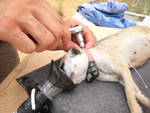Since Flower’s death in series III of Meerkat Manor, a number of people have contacted us with concerns about the welfare of meerkats. While we do not interfere to prevent natural mortality, we do our best to ensure that our research on the meerkats never affects them adversely.
Observation is and remains the most important of our experimental procedures, but it is complemented by other types of procedures. This site gives an overview over the following techniques:
- Weighing
- Radio collars
- Captures
- Feeding experiments
- Sound and presentation experiments
- Hormonal experiments
This paradigm shift represented by the last three techniques, from observational to experimental research, follows a trend in behaviour science: Experimental approaches have not only become a standard in our field of research; they are today deemed a prerequisite for scientific work – and therefore for obtaining research funds. By agreeing to perform a number of controlled experiments, we have also laid the financial foundation for another five years of operation of the Kalahari Meerkat Project.
We take utmost care to make sure that all our techniques are performed in a way that minimises the impact on the meerkats. The following chapters strive to give more detailled information and background to this.
Our research is overseen both by Northern Cape Nature Conservation and by the University of Pretoria Ethical Committee.
Weighing
Animals are persuaded with crumbs of egg or with small amounts of water to climb onto electronic balances, so that they can be weighed and we can measure their growth. Meerkats pups are trained to accept a certain amount of handling, to improve their habituation, but older animals are touched or handled as little as possible.
Radio Collars
Since the ranges of groups are large, we fit radio-collars on one or two animals per group to allow us to locate them. We have investigated whether carrying a radio-collar has any adverse effects on the animals (see Golabek et al. 2008 – click here for abstract) and found that it does not. We regularly check that collars are not too tight and remove them if there is any problem: for example, when animals are bitten by snakes or suffer other injuries, we check that collars are not restricting and remove them if so.
- Adjusting the collar
- Anaesthetised meerkat
- Release after collaring
Captures
Animals are occasionally caught and anaesthetised using Fluothane to allow blood samples to be collected: our catching procedures have been developed in collaboration with experienced vets and use equipment (including a portable oxygen supply and a flow regulator) usually only available under hospital conditions. We occasionally euthanase animals in the late stages of tuberculosis to reduce the spread of the disease but do not kill animals for experimental purposes.
Feeding experiments
The effect of the nutritional status on a meerkat’s behaviour is one of the centerpieces of our research. In order to test certain hypotheses, we occasionally provide a few animals in our population with extra egg. The animal in question is fed separately before or after the weighing session, and experiment duration is kept as short as possible to avoid the meerkats getting too keen on egg.
Other experiments related to feeding, mainly in the context of learning and teaching techniques, include scorpion feeds. Live scorpions are dug out of the sand by experienced staff, prepared according to the test setup (e.g. sting removed) and presented to the test animal. The procedure mimicks the way helpers present scorpions to the pups, as gleaned from years of observing pup feeds. There hasn’t been any scorpion-related incident or fatality, for the meerkats nor humans, in the past years.
Playback and presentation experiments
Communication and cognition in meerkats is the main interest of our Zurich University team. To test some of our hypotheses, we use playback or presentation experiments.
Playback experiments often start with recording a meerkat’s vocalisations (calls) issued in a specific context (e.g. an alarm call, a recruit call, a sunning call etc.). These records are then played back to other meerkats, to test whether they react in the expected way.
Presentation experiments work similarly: one or several meerkats are presented with an item or odour that is expected to trigger a certain reaction, e.g. mobbing to zorilla or cat hair, alarming to a raptor silhouette, or scent marking over an odour.
Also, a more specific type of presentation experiment is used for our ‘cognitive’ or ‘personality’ studies, in that we look at an animal’s ability or determination (perseverance) to solve a puzzle (such as getting a food item out of something), under specific circumstances.
Reactions to both playbacks and presentations are often filmed, in order to obtain as much information as possible out of one experiment. Utmost care is also taken to ensure that the meerkats do not get habituated to the artificial calls, items or odours; for this reason the experimental protocol demands that a minimal period between playbacks or presentations is respected (e.g. a predator alarm playback must not be played sooner than one week after the previous).
Hormonal experiments
As a research project concentrating on animal behaviour, the hormonal influences on behaviour are of high interest to us.
Over the years we have established a detailed record of the hormonal status of our meerkats, depending on age, sex or social status. A lot of hormonal data can be obtained noninvasively, by analysing urine or fecal samples of individual meerkats, whereas the levels of other hormones are measured from blood samples. More recent experiments try to understand the effect of sex hormones, mainly in the context of the dominants’ aggression.
One experiment strives to analyse the effect of subordinate females’ pregnancies on the dominant female’s aggression levels. To this aim, subordinate females of select groups are given a contraceptive, DPP, to prevent them from getting pregnant for a certain period (e.g. one breeding season). Focal observations of both the dominant and subordinate females throughout the experiment’s duration then try to capture potential differences in aggression levels, or other behaviour, e.g. the frequency of evictions.
Another hormonal study has started with our Duke University team. It tries to answer the question of what it takes for a female to become dominant. It is well known for meerkats and certain other species that dominant females have higher levels of testosterone, the “male” hormone often associated with aggression, than their subordinate counterparts. Furthermore, the proportion of dominant females’ daughters gaining dominance themselves is higher than that of subordinate females’ daughters. But what are the factors that influence which female becomes dominant, and how? Does the mother’s testosterone level during pregnancy influence a daughter’s likeliness to become dominant herself? The experimental part of this study involves reducing the effects of testosterone during the last three weeks of a dominant’s pregnancy using the anti-testosterone drug flutamide. Again, both the mother and the pups are closely observed in order to capture differences in behaviour; long-term life history data will reveal whether the lack of testosterone effects before birth will influence the offspring’s likeliness to become dominant.
With both the DPP and flutamide experiments, we take utmost care to reduce intervention to a minimum by using optimised experimental protocols.
- Both drugs are well known and widely used in several species (e.g. DPP is used to prevent pregnancies in zoo meerkats, or flutamide is used to treat balding in men or excess testosterone levels in women). The correct doses, appropriate methods and ways of action are therefore well documented.
- The study uses implants with a drug dose that wears off after a defined period. This minimises the number of handling and anaesthesias needed.
- Both drugs have entirely reversible actions; females become fertile again, and both males and females return to their usual aggression levels once the effects of DPP or flutamide, respectively, wear off.





